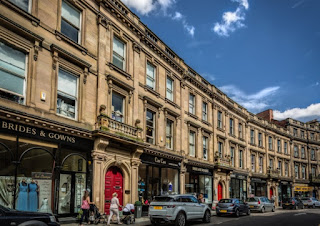Derbyshire is a mix of High Peaks and glorious dells where rivers wend through steep valleys to reveal undulating slopes and flat river plains. In like to much of England, the county has numerous bridges from small pack horse bridges to the grand multi-span arched bridges. Often as not the moorland and peaks are shrouded in mist which lends the upper slopes to sense of a Gothic landscape erring somewhat creepy and mysterious to strangers, and can lead to finding oneself lost even with modern road signs. Whereas, in the Georgian era there were but milestones and no doubt as today, they were part shrouded in moss or ground ivy because locals knew their way around and no one bothered to clear away the creeping flora! Wooden signposts on high ground were prone to collapse in high winds of yesteryears, unlike the later mid-Victorian Iron signposts.
There are several grand estates within Derbyshire, not least the country seat of the Duke's of Devonshire at Chatsworth House, and Hardwick Hall, both houses within the Cavendish family hands at that time!
Painting of Chatsworth circa 1785
Chapter 43 Pride and Prejudice - Jane Austen:
Elizabeth, as they drove along,
watched for the first appearance of Pemberley Woods with some perturbation, and
where at length they turned in at the lodge, her spirits were in a high
flutter.
The park was very large, and contained great variety of ground. They
entered it in one of the lowest points, and drove for some time through a
beautiful wood stretching over a wide extent.
Elizabeth’s mind was too full for conversation but she saw and admired
every remarkable spot and point of view. They gradually ascended for a half-a-mile,
and there found themselves at the top of
a considerable eminence, where the wood
ceased, and the eye was instantly caught by Pemberley House, situated on the
opposite side of a valley, into which the road with some abruptness wound. It
was a large, handsome stone building, standing well on rising ground , and
backed by a ridge of high woody hills; and in front, a stream of some natural
importance was swelled into greater, but without any artificial appearance. It
banks were neither formal nor falsely adorned.
In my JAFF novel I chose Buxton as the main country spa town nearest to Pemberley, in part because Jane Austen mentioned High Peak which is a long way north of Matlock. And although it is claimed Jane Austen stayed at The Rutland Arms in Bakewell, thus Mrs. Gardiner's Lambton is based on Bakewell, Buxton seemed closer to Pemberley's imagined location; based on the fact it couldn't be Chatsworth as Elizabeth and the Gardiners' had ventured to see Chatsworth and other en route.
Chatsworth today.
Chapter 42 Pride and Prejudice JA.
In that county there was enough to
be seen to occupy the chief of their three weeks; and to Mrs. Gardiner it had a
peculiarly strong affection. The town where she had formerly passed some years
of her life, and where they were now to spend a few days, was probably as great
an object of her curiosity as all the celebrated beauties of Matlock,
Chatsworth, and Dovedale, or the Peak.
All in all Jane could have used several small market towns as her template for "Lambton" but Buxton gives greater scope for novelists due to its link with the 5th Duke of Devonshire. Aside from which, if Mrs. Gardiner's parents were of trade, as was Mr. Gardiner, the chances were they had dealings with Chatsworth, as would tradespeople of Bakewell (either Bakewell or Buxton = Lambton), both places in relative proximity to Chatsworth, barring a closer relationship betwixt Buxton and Chatsworth.
A beautiful Crescent was built within Buxton by the 5th Duke of Devonshire. At the rear was a grand stable complex with a dome. The latter was built to house horses and equipage of the rich whilst the aristocracy who resided within the crescent partook of the Buxton waters, just as many people partook of the waters in fashionable Bath & Cheltenham, and other spa towns. It was essentially the Bath of the North, at its highest elevation of approx 1,000 feet above sea level!
The Devonshire Dome.
Derby itself is south of the county.
Derby's Georgian heritage is apparent within its architecture!
And Matlock through which Jane Austen travelled, and here one can see older architecture mingling with Victorian Gothic.
Needless to say, wherever authors choose to set their JAFF characters, north of the county seems best for P&P, close to Chatsworth and close to High Peak.
If you wonder why I do larger text it's because many people have said they can't read small or faint text on blogs. So please forgive me if your sight is very good...





















